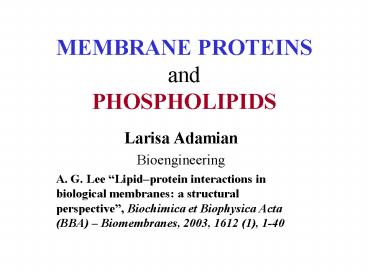MEMBRANE PROTEINS and PHOSPHOLIPIDS - PowerPoint PPT Presentation
1 / 21
Title:
MEMBRANE PROTEINS and PHOSPHOLIPIDS
Description:
A. G. Lee 'Lipid protein interactions in biological membranes: a structural ... Annular shell of lipids; X-ray structures of membrane proteins with lipids; ... – PowerPoint PPT presentation
Number of Views:83
Avg rating:3.0/5.0
Title: MEMBRANE PROTEINS and PHOSPHOLIPIDS
1
MEMBRANE PROTEINS and PHOSPHOLIPIDS
- Larisa Adamian
- Bioengineering
- A. G. Lee Lipidprotein interactions in
biological membranes a structural perspective,
Biochimica et Biophysica Acta (BBA)
Biomembranes, 2003, 1612 (1), 1-40
2
Topics
- Annular shell of lipids
- X-ray structures of membrane proteins with
lipids - Nature of lipid binding
- Effect of a phospholipid phase
- Non-annular sites
- Bilayer thickness and membrane protein function
- Lipids and protein-protein interactions.
3
(No Transcript)
4
Phospholipid
5
Photosynthetic reaction center from R. sphaeroides
Hydrophobic surface is rough
Fyfe et al, TIBS(2001), v.26(2)
6
Lipid-protein interaction is slightly more
favorable than lipid-lipid interaction
- ESR (electron spin resonance)
- Subpopulation of highly immobilized lipids
- Not present in protein-free membrane
- Number of bound lipids fits to the expected
circumference of the TM region - Ca2 - ATPase ESR exp.data 32 lipids,
structure-based 30 lipids. - Length of time
- On rate constant controlled by diffusion
8x107 s-1, 30 ºC - Off rate constant reflects specificity in
binding 1-2x107s-1, - 30 ºC
7
Annular lipids solvent for the membrane
protein
Equilibrium at each binding site PAB?PBA Rela
tive association constant KPBA/PAB
Lipid binding sites on the TM surface of a
membrane protein. Two lipids, A and B, are shown
exchanging at one site.
8
Relative association constants for lipid-protein
interactions, determined from ESR experiments
with spin-labelled lipids
CL, cardiolipin PA, phosphatidic acid PS,
phosphatidylserine PG phosphatidylglycerol, PE,
phosphatidylethanolamine. Data from D. Marsh et
al, Biochim. Biophys. Acta 1376 (1998) 267-296
9
X-ray structures of MPs
The surface of the bR showing bound lipid
molecules (green). A squalene molecule is shown
in red. (PDB file 1C3W).
10
Binding sites for phosphatidylcholine (PC) on
cytochrome c oxidase of P. denitrificans.
Top TM region with two bound PC molecules.
Salt bridges between the phosphate and
quaternary ammonium in the lipid headgroup and
Arg-198 (II) And Asp-124 (III). Bottom a
view of the complex from the periplasm, showing
how the phosphatidylcholine molecules (PC) bind
in deep grooves in the side of the protein.
(PDB files 1QLE). (From Lee, BBA(2003))
11
The photosynthetic reaction center from T.
tepidum showing the bound PE molecule
- The structure with the Trp residues and the bound
PE. - The PE molecule and the residues with which the
lipid - headgroup interacts.
- (PDB file 1EYS). From Lee, BBA(2003))
12
The nature of the lipid binding site
- Lipid fatty acyl chains are surrounded by
hydrophobic residues - W, I, L, F V
- Good van der Waals contacts between chains and a
protein are ensured by binding into distinct
grooves on the surfaces of TM helices - These chains are usually resolved in X-ray
structures - Phospholipid headgroups are often disordered in
X-ray structures - Resolved head groups are involved in
electrostatic and H-bond interactions with the
protein
13
Effects of phospholipid phase
- MPs prefer lipid in the fluid, liquid crystalline
phase over rigid gel phase - Lipid in a gel phase will make poorer vdW
contacts with MP - Binding of gel phase lipid to Ca2-ATPase is 25
times weaker than binding of lipid in liquid
crystalline phase - In bilayers containing lipids in both phases,
proteins will partition preferentially into
domains in the liquid crystalline phase
14
Annular vs. Non-annular sites
- Annular sites non-sticky binding of
phospholipids - Non-annular sites specific binding of
hydrophobic molecules, e.g. cholesterol binding
site in Ca2-ATPase or palmitic acid in
halorhodopsin. - Some phospholipid molecules bind deeply into
crevices of the MPs gt the definition of
non-annular binding site should be extended. - Solvent lipids and cofactor lipids
- Lipids in non-annular binding sites slow
exchange with the surrounding lipids?
15
Effects of fatty acyl chain length on membrane
protein function
F.Dumas et al, Biochemistry 2000, 39, 4846
J.D.Pilot et al, Biochemistry 2001, 40, 8188
Influence of lipid acyl-chain length on
melibiose transport and counterflow in
proteoliposomes.
Effect of PE fatty acyl chain length on DGK
activity. PE with two monounsaturated fatty
chain in the liquid crystalline phase.
16
Bilayer thickness affects the activity of
membrane proteins
- High cost of exposing hydrophobic acyl chain or
part of a TM domain to water - Thickness of TM helix should match the
hydrophobic thickness of bilayer - Adjust thickness of a lipid bilayer
- Adjust thickness of a membrane protein
17
Adjust thickness of lipid bilayer
Lipid chains compress
Lipid chains stretch
Lipid bilayer could distort around MP with
hydrophobic thickness greater than that of the
lipid bilayer (left dpgtdl) or less than that of
the lipid bilayer (right dpltdl)
18
Binding constants as a function of fatty acyl
chain length
Energetic cost of the change of thickness of
bilayer Strongest binding in the case when
there is no need for adjustment of
thickness OmpF vs. KcsA b-barrel vs. a-helix
gt KcsA distorts to match the Lipid bilayer.
Relative lipid binding constants for OmpF (?),
KcsA (?)and Ca2-ATPase(































